D - Reviews
This is the page for reviews of books, videos, trips, etc connected with branch lines or railways in general.
If you have a review to submit for this page, contact us here.
Please note reviews of journeys along branch lines will be put on that branch line's page.
 |
SOUTH YORKSHIRE RAILWAYS - ANDREW WALKER & JOHN WALKER (AMBERLEY BOOKS)
South Yorkshire Railways is a photographic record of the many and varied trains and stations that can be found in the South Yorkshire area. It includes photographs of such locations as Doncaster, Tinsley, Wath, Barnsley, Sheffield and Rotherham. It has photographs ranging from the 1970s right through to the 2010s. I was pleased to see some photos of the Class 76s on the Woodhead Line and at Wath Yard, as it is one of my favourite locos. There is a pleasing mixture of old and new and the authors show how many lines have been closed in this area with the decline of coal traffic. In all there are almost 200 colour and black and white photographs. As usual Amberley Books have done a good job in producing a professional looking book showing one aspect of our transport network.
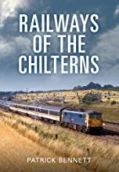 |
RAILWAYS OF THE CHILTERNS - PATRICK BENNETT (AMBERLEY BOOKS)
This book looks at the history of the various lines that run through the Chilterns area including the West Coast mainline, the Chilterns Line and the Midland mainline. These are the lines that are open today, but it also covers lines that once ran in this area like the Leighton Buzzard to Dunstable Branch, the Brill Branch and the Nickey Line. It contains a good mixture of both new and old photographs and I am pleased to say that there are some photographs of the stations, as well as the trains that run through them. Plus, there are quite a few ‘before and after' shots which makes the book more interesting. The text is not continuous but is placed after each photograph, which helps to make the book easier to digest so to speak. All in all a worthy effort by the author Patrick Bennet.
 |
RAILROVER EAST MIDLANDS ROVER - JOHN JACKSON (AMBERLEY BOOKS)
When I saw the title of this book, I thought it was about the exploits of someone who had travelled all over the East Midlands region on a rover ticket. It's not quite that, but does cover many of the stations that you can travel to, on an East Midlands river ticket. Basically, it is a collection of various photographs of trains and locomotives taken at stations such as Stafford, Derby, Doncaster, Peterborough and Sheffield. Each photograph has some text underneath it, giving information about the station and/or the train passing through it. The photographs are of good quality, but this book is really for those who like their locomotives, rather than those who want to find out some more about the history of each station covered in the book.
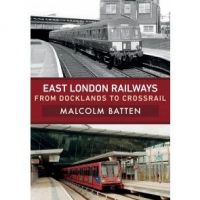 |
EAST LONDON RAILWAYS - FROM DOCKLANDS TO CROSSRAIL - MALCOLM BATTEN (AMBERLEY BOOKS)
This is a comprehensive account of all of the various railways that can be found in the East London area and how things have changed since the 1970's. It includes both national railway lines, London Underground and Overground routes and the Docklands Light Railway. Backed with many interesting colour photographs of both trains and stations, as well as maps, this is an excellent guide for those who want to find out more about the history and workings of the railways in this part of London. Sadly, the book has come out before the Crossrail Project was completed, but that is not the author's fault. Perhaps an update might be made when this ongoing project finally happens?
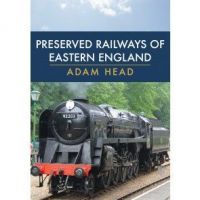 |
PRESERVED RAILWAYS OF EASTERN ENGLAND - ADAM HEAD (AMBERLEY BOOKS)
This book looks at seven different preserved railways that can be found in eastern England, though I am not sure whether Barrow Hill Depot really counts as a preserved railway! There are plenty of colour photographs of preserved locomotives with captions, though I would say about 90% of them are of diesels, which is a pity. More photographs of steam locomotives might have helped keep a balance, especially as most of the lines tend to have steam locomotives as their main mode of transport when they have running days. Also, it would have been nice to have a few more photos of some of the station buildings such as the one at Wakes Colne with its recreation of a 1930's ticket office. Finally, it doesn't include all the preserved lines that can be found in the east of England such as the Colne Valley Railway, the Tanfield Railway or the Mid-Suffolk Railway. Perhaps a future edition might include these?
 |
BRITISH RAILWAY INFRASTRUCTURE SINCE 1970 - AN HISTORICAL OVERVIEW BY PAUL D. SHANNON (Published by Pen & Sword Books)
This book looks at all the various changes that have taken place in Britain's railways since 1970. In other words - over the past 50 years. Such things as freight, stations closing and opening, or re-opening, locomotive depots and signalling are all covered in detail. What makes this book so good is the number of photographs supplied by the author ranging from back in the 1970s to the present. This is a book worth having if you are interested in the infrastructure of Britain's railways. Beautifully illustrated.
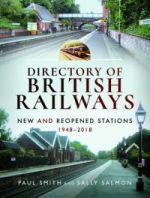 |
DIRECTORY OF BRITISH RAILWAYS - NEW & REOPENED STATIONS 1948-2018 - Paul Smith and Sally Salmon (Published by Pen & Sword Books)
This book is really just a list of all the various stations that have been opened or reopened in the last seventy years, so I'm not sure that the title is quite right for this book. "Directory of British Railways" could mean a whole host of different things to different people. Why not call it "A Directory of new and reopened stations in Britain from 1948-2018"? Much clearer I think. Inside there isn't much information for each station; merely its address, co-ordinates and number of passengers who have used it in the previous year. A little bit of each station's history would have been welcome. There are several photographs of some of the stations on each page which does break up the text, though the problem is most seem to have been taken from the same angle - all looking down the platform at the tracks, which can be quite monotonous after a while. Admittedly some of the photographs do include a train in the station which does make them more interesting. Perhaps some of the photos could have showed the station building from the outside, which would have made them a little more palatable? Another problem with some of the photos is they are too dark, looking like they were taken at dusk, which is a pity. So really this is a book which may only appeal to the die hard fan of railway stations.
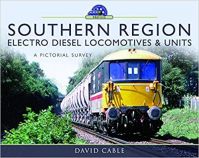 |
Southern Region Electro Diesel Locomotives and units - David Cable (Published by Pen & Sword Books)
This book is essentially a collection of photographs of the various locomotives and units that were/are to be found exclusively on the Southern Region area of Britain's railways mainly towards the end of the 20th century. The book tends to concentrate on the Class 73 locomotives in particular, with every possible livery in existence included. There are also some Class 74's included, as well as photos of the Class 201 to 207 units. Each photograph has a short caption underneath giving details of the loco/unit in the photo and the date it was taken. It will be of interest to those railway enthusiasts who are fans of this area of Britain.
 |
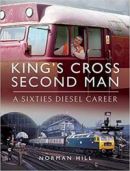 |
King's Cross Second Man - A Sixties Diesel Career by Norman Hill (Published by Pen & Sword Books)
This book tells the story of Norman Hill who began working for British Railways in the 1950s as a clerical worker in the London Midland Division. After changing to the role of locomotive cleaner at Kings Cross station, he was eventually promoted to the post of second man. This involved accompanying the main driver as their locomotives transferred stock, mainly in the North London area and sometimes as far north as Peterborough. Each journey he made was meticulously recorded in great detail which forms the background to this book. This is quite a detailed book, which may put the average reader off, as a lot of it is detailed accounts of moving stock around. For me there was too much "railway speak" about what was going on, which made it difficult to understand the text. Also, more photos would have helped to break up the text more. It will appeal to those who work or worked on the railways, but maybe not to the casual railway enthusiast.
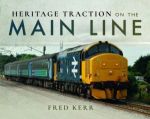 |
HERITAGE TRACTION ON THE MAIN LINE - FRED KERR (Published by Pen & Sword Books)
This book looks at all the various preserved classes of locomotives, both diesel and electric, still working both passenger and freight trains on Britain's raliway lines in the 21st century. All the photos are in colour with suitable commentary accompanying each photograph. The scope and quality of each photograph is to be commended. There is such a wide range of locomotives in the book that it is impossible to mention them all. However highlights include Class 55, Deltic, 55022 Royal Scots Grey on a North Blyth to Lynemouth freight working; Class 52, D1015 Western Champion on an excursion on the North Wales mainline; Class 40, D345/40145 East Lancashire Railway on various tours; and Class 86 Electric loco 86259, les Ross on the West Coast mainline. A high quality book with high quality photographs.
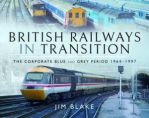 |
BRITISH RAILWAYS IN TRANSITION - THE CORPORATE BLUE AND GREY PERIOD 1964-1997 - JIM BLAKE (Published by Pen & Sword Books)
The years 1964 to 1997 saw many changes in Britain's railways, including the end of steam, the introduction of diesel and electric locomotives, changes in coaching stock and the corporate blue livery on many locomotives. This book chronicles all these changes and many more with a wide array of both black and white and colour photographs from the camera of Jim Blake. Whilst many of the photographs in the book are from the London area, the rest of the country is not forgotten with photographs of locomotives and trains at such places as Perth, Peterborough, Southampton, Rotherham, Glasgow and Manchester. Each entry has a detailed commentary explaining what is going on and just by looking at the photographs you will be taken back to a time when things were a little more simple and the railways were perhaps more interesting than they are today.
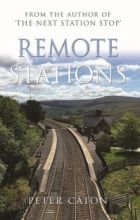 |
REMOTE STATIONS BY PETER CATON (Published by Matador Books)
The Next Station Stop by Peter Caton
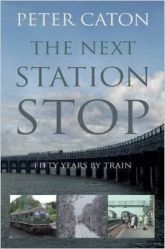 |
As someone who has travelled extensively on Britain's railway network for work and for pleasure, I found this book both interesting and enjoyable. The author, Peter Caton has walked a fine line between keeping the railway enthusiasts happy on one side, and the casual train traveller on the other. He seems to have achieved it with this book, managing to add the odd historical anecdote along the way.
The main premise of the book is comparing train journeys he made as a child in the sixties and seventies, with those he makes with his work in more recent years. He is not afraid to put forward his views on such train related subjects as ever increasing train speeds, on board catering, train announcements and anti-social passengers. There are a few extra chapters at the end where he has ventured into Europe by train. These are also compared with Britain's present railways.
All in all an intriguing read, with plenty to amuse, entertain and interest the reader; all written in a clear and concise style, Plus, there are several colour photos showing trains and stations from his younger days, which are compared with their modern equivalent.
Book Review
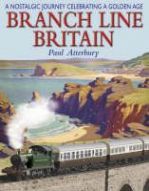 |
Branch Line Britain by Paul Atterbury (Published by David & Charles)
Paul Atterbury has produced the ultimate book on branch lines. Not only is the text informative and a delight to read, but also it is backed up by a wealth of excellent illustrations. The publishers have gone to town in providing many colour photos of branch line stations and traction from fifty and even sixty odd years ago. These are backed up with many original tickets, posters and postcards from a bygone era, all of which help to bring the text to life.
Over sixty branch lines are covered, from all parts of the country. These are split into three different categories. Firstly those which are still operating on the current railway network; secondly those which are in operation as heritage lines; and thirdly those that have sadly disappeared from the landscape altogether. Indeed there are photos of mounds in fields that once carried a branch line across the countryside. There's also several extra sections on such things as railcars, camping cars and seaside postcards, which all help to bring the past to life. This is a book well worth having in your collection, not just for the railway nostalgia, but also the valuable social history it covers.
